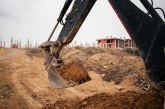

By David M. Greenwald
Executive Editor
When I first started the Vanguard, growth control policies were seen as a primary local means for environmental protection. However, increasingly I have come to see the need to develop affordable housing near jobs, schools and transit as deeply interconnected with mitigating climate change.
As an op-ed by Liz O’Donoghue and Melissa Breach in Los Angeles Times this week demonstrates, “California’s housing shortage and climate crisis are often treated as if they are unrelated to each other. In fact, they are deeply interconnected.”
Melissa Breach is the chief operating officer of California YIMBY. Liz O’Donoghue is the director of sustainable and resilient communities strategy for the Nature Conservancy.
You may think of them as the odd couple, but they recognize that the housing shortage and climate crisis are not unrelated to each other.
“Without enough affordable housing near jobs, schools, transit and other resources in existing communities, Californians are increasingly forced into long commutes from remote areas that are often more vulnerable to wildfires, flooding and other climate-accelerated disasters,” they write.
Some have argued that the state should address its housing needs not by creating dense  housing in existing communities close to jobs and transit, but in new locales where the housing will have less impact on existing residents.
housing in existing communities close to jobs and transit, but in new locales where the housing will have less impact on existing residents.
In fact, they argue this has been happening in California over the last several decades.
Between 1990 and 2010, “half the housing development in California was at the edge of wilderness areas, known as the ‘wildland-urban interface,’ or WUI. As a result, about 25% of Californians live in areas at high risk of catastrophic wildfire.”
They argue, “Expanding development into natural lands not only puts more people in harm’s way; it also increases the likelihood, frequency and devastation of fires, floods and other disasters.”
Moreover, “California has lost more than 1 million acres of natural habitat to development over the past 20 years.”
They argue, “We need to reframe the way we think about the relationship between housing policies and climate change. We need to significantly increase the number of homes we build, but if we do so in the undeveloped wildland-urban interface, we will only worsen the climate crisis.”
They argue, “Building housing far from jobs doesn’t just require longer commutes and new roads, increasing the pollution that causes climate change. It also reduces the landscape’s ability to store carbon by paving over natural and agricultural lands that would otherwise remove it from the atmosphere.”
So what is their answer?
One piece of legislation they are looking at is AB 68.
Last week, Assemblymember Chris Ward introduced the Housing and Climate Solutions Act.
The goal of AB 68 is to make it “faster and easier to build more homes near jobs, schools, transit, and other resources, while adding provisions to state law that will help protect Californians from increasingly frequent and severe wildfires and floods.”
“Our housing and climate crises are intertwined, and our solutions must be too,” said Assemblymember Chris Ward (D-San Diego).
He explained, “Our current land use policies have left unchecked sprawl that puts more Californians in harm’s way, increases climate pollution, and strains infrastructure. AB 68 will make sure local governments follow their existing plans to build needed infill housing in climate-safe areas, and enable more Californians to live in walkable neighborhoods, near jobs, schools, and transit.”
One key to AB 68 is it makes it easier to build housing in safe, environmentally smart locations. And it does so “by requiring such housing to be approved through an objective, streamlined process that eliminates needless delays.”
“Too many Californians have been forced to live in areas that are in the crosshairs of catastrophic climate impacts,” said Melissa Breach.
She explained, “Our housing policies should minimize risk and protect our residents – but instead, they’re adding fuel to the fire. We have to deprioritize building homes in hazard zones and instead prioritize housing closer to jobs and services, so people can spend more time with their families – and less time in polluting traffic. AB 68 will ensure we build safe and affordable homes in our communities and give more Californians access to a climate-safe future.”
“It shouldn’t be surprising to see an environmental conservation organization co-sponsoring a housing bill. This legislation reflects the urgent need to reach out across sectors to meet California’s housing needs in climate-smart locations,” said Liz O’Donoghue
She added, AB 68 is an opportunity for California to meet its housing needs and ensure cities grow with nature and a changing climate in mind. The bill thoughtfully considers where we build new homes and provides incentives to build in safe and sustainable locations.”
“The scarcity of housing in existing walkable neighborhoods, close to schools, parks, transit and jobs, has increasingly left working families — especially people of color — with no choice but to move to remote areas that are far from opportunities and resources, and more susceptible to wildfires and floods,” said Ricardo Flores, LISC San Diego.
He explained, “Lower-income Californians and communities of color are 50% more vulnerable to the long-term destructive effects of wildfire. AB 68 will enable more people at all income levels to live where they want to live, in places that are safer.”
Breach and O’Donoghue point out a key component to the law: “This legislation’s counter-mandate — don’t sprawl unless you must — takes a novel approach to land use.”
They note, “For most of the last 50 years, California’s tight restrictions and outright bans on dense, multifamily housing in existing neighborhoods have made low-density, single-family, greenfield housing the default when we do accommodate growth.”
They explain, “And while recent legislative reforms have sought to ease development of affordable, multifamily housing in cities by reducing zoning, planning and other restrictions, it’s still easier in many cases to build in rural areas that are more vulnerable to fires and floods.”
They believe “AB 68 would begin to correct the incentives that too often pit the need for housing against environmental stewardship by encouraging sprawl.”
For me, the need to recognize the link between poor housing policies and the climate emergency is essential for reframing the issue – building dense new housing near transit and jobs is the only way to solve both the housing and climate emergency in our lifetime.







I read the article that’s being referenced here, yesterday.
One problem with it is that there’s no mention at all regarding any effort to contain sprawl (or building in fire-prone wild areas, for that matter).
As evidenced by multiple developments throughout the region (including some close to Davis), efforts to promote infill do NOT prevent sprawl – which is still occurring despite a declining state population.
Since our “system” gives people a choice, most people will choose lower-density, less-expensive housing (especially with the advent of telecommuting). We’re already seeing this, in regard to a loss of population in places like San Francisco. And a corresponding drop in the use of public transit (which prompted the governor to propose a cut in funding of public transit).
In the long run, never-ending “infill” is also not sustainable.
You know what is sustainable? A stable population. Which is a concept that sends shudders down the spines of institutions and businesses which prefer never-ending growth.
Actually, the bill itself might have a provision which addresses some of this. It’s difficult to determine, based upon the language of the bill itself:
https://leginfo.legislature.ca.gov/faces/billNavClient.xhtml?bill_id=202320240AB68
It will be interesting if something like the Shriner’s property or DISC proposal site is determined to be a “climate resilient land”.
“No water or sewer lines for you”, thank you very much.
I think I’m “this close” to being a supporter of AB 68. Hopefully, the powers that be won’t force a change to this part (though I suspect they’re already working on it). Though again, it depends upon how those lands are defined in the first place.
“It will be interesting if something like the Shriner’s property is determined to be a “climate resilient land”.”
It shouldn’t – not in a high fire area, next to an urban boundary, etc.
You’re inserting definitions that aren’t found in the language of the bill.
But if it doesn’t prevent or discourage conversion of farmland for urban sprawl, then it’s not an environmental bill.
Though I’m gathering from the language that it might discourage development in high-risk fire zones.
But one thing I find interesting is that California YIMBY claims that cities can develop lands outside their boundaries only “when” they can demonstrate that there is no other way of meeting their housing goals, under this bill. (See second page of the referenced document.)
https://cayimby.org/wp-content/uploads/2023/03/AB-68-The-Housing-and-Climate-Solutions-Act-Fact-Sheet.pdf
But again, I’m not seeing that wording in the actual bill, itself. So I’m wondering if California YIMBY (whom I already don’t trust) is misinterpreting this.
To clarify, they don’t use the word “only”. (I’m not able to copy the exact text.)
But they also refer to preserving “natural and working” landscapes outside of existing communities. By “working”, I assume they might be referring to farmland.
The document itself appears to be from the the assembly member’s office, but is available via California YIMBY’s website.
As mentioned, I suspect that the “powers that be” will work toward shutting down any language that would prevent them from converting farmland for urban sprawl, before the bill is finalized for potential approval. I wouldn’t be surprised if they were on the phone this very minute, calling the assembly member who wrote this bill.
https://cayimby.org/wp-content/uploads/2023/03/AB-68-The-Housing-and-Climate-Solutions-Act-Fact-Sheet.pdf
But if it remains as is, perhaps Measure J wouldn’t even be needed to reign-in sprawl. Difficult to determine, right now.
In any case, I hope that by bringing this up here, no one is tipping-off their developer friends.
Then again, I’m sure that they, their attorneys, and their lobbyists are already scrutinizing every bill that makes it way through the legislature.
The state has been stupid in both pushing and allowing development at the wildland-urban interface (WUI). Now PG&E is planning on investing $40 billion in undergrounding distribution lines to bail out those living in those WUI communities and the rest of us will pay for it through rate increases of at least 50% on top of already high rates. It may be cheaper to simply buy out those houses and empty those areas.